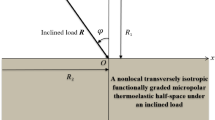Abstract
Dilute, Self-Consistent (SC), Mori-Tanaka (MT) and differential micromechanics methods are developed for microcrack- weakened thermopiezoelectric solids. These methods are capable of determination of effective properties such as the conductivity, electroelastic moduli, thermal expansion and pyroelectric coefficients. The above material constants affected by the microcracks are derived by way of Stroh's formulation and some recently developed explicit solutions of a crack in an infinite piezoelectric solid subjected to remote thermal, electrical and elastic loads. In common with the corresponding uncoupled thermal, electric and elastical behavior, the dilute and Mori-Tanaka techniques give explicit estimates of the effective thermoelectroelastic moduli. The SC and differential schemes, however, give only implicit estimates, with nonlinear algebraic matrix equations, of the effective thermoelectroelastic moduli. Numerical results are given for a particular cracked material to examine the behavior of each of the four micromechanics models.
Similar content being viewed by others

References
Atkinson, C. and Clements, D.L. (1977), On some crack problems in anisotropic thermoelasticity. International Journal of Solids and Structures 13, 855–864.
Benveniste, Y. (1987), A new approach to the application of Mori–Tanaka's theory in composite materials. Mechanics of Materials 6, 147–157.
Benveniste, Y. (1993), Universal relations in piezoelectric composites with eigenstress and polarization fields, I: Binary media: local fields and effective behavior. Journal of Applied Mechanics 60, 265–269.
Budiansky, B. and O'Connell, R.J. (1976), Elastic moduli of a cracked solid, International Journal of Solids and Structures 12, 81–97.
Chung, M.Y. and Ting, T.C.T. (1995), Line force, charge, and dislocation in anisotropic piezoelectric composite wedges and spaces. Journal of Applied Mechanics 62, 423–428.
Delale, F. and Erdogan, F. (1979), Bonded orthotropic strips with cracks. International Journal of Fracture 15, 343–364.
Delameter, W.R., Herrmann, G. and Barnett, D.M. (1975). Weakening of an elastic solid by a rectangular array of cracks. Journal of Applied Mechanics 42, 74–80.
Dunn, M.L. (1993a), Micromechanics of coupled electroelastic composites: effective thermal expansion and pyroelectric coefficients. Journal of Applied Physics 73, 5131–5140.
Dunn, M.L. (1993b), Exact relations between the thermoelectroelastic moduli of heterogeneous materials. Proceedings of the Royal Society of London 441A, 549–557.
Dunn, M.L. (1994), The effects of crack face boundary conditions on the fracture mechanics of piezoelectric solids. Engineeering of Fracture Mechanics 48, 25–39.
Dunn, M.L. and Taya, M. (1993), Micromechanics predictions of the effective electro–elastic moduli of piezoelectric composites. International Journal of Solids and Structures 30, 161–175.
Fares, N. (1992), Effective stiffness of cracked elastic solids. Applied Mechanics Reviews 45, 336–345.
Hashin, Z. (1985), Analysis of cracked laminates: a variational approach. Mechanics of Materials 4, 121–136.
Hashin, Z. (1988), The differential scheme and its application to cracked materials. Journal of Mechanics Physics of Solids 36, 719–734.
Hoenig, A. (1979), Elastic moduli of a nonrandomly cracked body. International Journal of Solids and Structures 15, 137–154.
Huang, Y., Hu, K.X. and Chanara, A. (1994), A generalized self–consistent mechanics method for microcracked solids. Journal of Mechanics Physics of Solids 42, 1273–1291.
Kachanov, M. (1987), Elastic solids with many cracks: a simple method of analysis. International Journal of Solids and Structures 23, 23–43.
Kachanov, M. (1992), Effective elastic properties of cracked solids: critical review of some basic concepts. Applied Mechanics Reviews 45, 304–335.
Laws, N. and Dvorak, G.J. (1987), The effect of fiber breaks and aligned penny shaped cracks on the stiffness and energy release rates in unidirectional composites. International Journal of Solids and Structures 23, 1269– 1283.
Mori, T. and Tanaka, K. (1973), Average stress in matrix and average elastic energy of materials with misfitting inclusions. Acta Metallurgica 21, 571–574.
Nye, J.F. (1957), Physical Properties of Crystals. Oxford University Press, Oxford.
Parton, V.Z. and Kudryatvsev, B.A. (1988), Electromagnetoelasticity. Gordon and Breach, New York.
Qin, Q.H., Mai, Y.W. and Yu, S.W. (1998a), Some problems in plane thermopiezo–electric materials with holes. International Journal of Solids and Structures. (Accepted for publication)
Qin, Q.H., Mai, Y.W. and Yu, S.W. (1998b). Overall thermal expansion and pyroelectric coefficients for cracked piezoelectric materials. Proceeding of ICNM–III, Shanghai, P.R. China.
Yu, S.W. and Qin, Q.H. (1996), Damage analysis of thermopiezoelectric properties: Part I and II. Theoretical and Applied Fracture Mechanics 25, 263–288.
Author information
Authors and Affiliations
Rights and permissions
About this article
Cite this article
Qin, QH., Mai, YW. & Yu, SW. Effective moduli for thermopiezoelectric materials with microcracks. International Journal of Fracture 91, 359–371 (1998). https://doi.org/10.1023/A:1007423508650
Issue Date:
DOI: https://doi.org/10.1023/A:1007423508650



